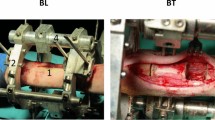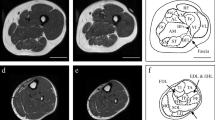Abstract
Introduction
Muscle regeneration is promoted when the Ilizarov method is used for limb lengthening and deformity correction, but the regenerative ability of muscles decreases when achieving large amounts of elongation. Much research has been dedicated to studying the capabilities of muscles under lengthening, but no reports are available that investigate the muscle metabolism. We supposed that energy turnover would be activated in skeletal muscles under lengthening as a response to distraction, and the activity of the energy turnover would grow in proportion to the increase in the distraction rate or amount.
Materials and methods
We compared the metabolism of canine anterior tibial muscles (ATMs) by regular and 3-mm high-frequency bone distraction in 30 dogs to obtain 14.5 ± 0.8 % lengthening from the initial tibial length. Group 1 (n = 12) had manual lengthening with a rate of 1 mm per day. Three millimeters per day was produced with 120 increments in automated mode in group 2 (n = 12). An intact group (n = 6) served as controls. ATMs were harvested at the end of distraction, after 30 days of fixation, and 30 days after frame removal. We assessed the activity of lactate dehydrogenase, creatine phosphokinase, glucoso-6-phosphate dehydrogenase, and catalase and calculated the concentration of malone dialdehyde, sarcoplasmic and contractile proteins in the ATM extract.
Results
Energy turnover reactions were activated in the ATM as a response to distraction forces, but the activity of the energy turnover did not grow proportionally to the increased distraction rate. Levels of sarcoplasmic and contractile proteins in the ATM decreased insignificantly in both groups.
Conclusions
High-frequency 3-mm daily lengthening results in compensatory energy turnover changes in the muscle, sufficient for prevention of catabolic processes.







Similar content being viewed by others
References
Ilizarov GA. The tension-stress effect on the genesis and growth of tissues: Part II. The influence of the rate and frequency of distraction. Clin Orthop Relat Res. 1989;239:263–85.
Birch JG, Samchukov ML. Use of the Ilizarov method to correct lower limb deformities in children and adolescents. J Am Acad Orthop Surg. 2004;12(3):144–54.
Catagni MA, Lovisetti L, Guerreschi F, Combi A, Ottaviani G. Cosmetic bilateral leg lengthening: experience of 54 cases. J Bone Joint Surg Br. 2005;87(10):1402–5.
Vargas Barreto B, Caton J, Merabet Z, Panisset JC, Pracros JP. Complications of Ilizarov leg lengthening: a comparative study between patients with leg length discrepancy and short stature. Int Orthop. 2007;31(5):587–91.
Kim SJ, Balce GC, Agashe MV, Song SH, Song HR. Is bilateral lower limb lengthening appropriate for achondroplasia?: midterm analysis of the complications and quality of life. Clin Orthop Relat Res. 2012;470(2):616–21.
Shetsov VI, Popkov AV. Limb lengthening in automatic mode. Ortop Traumatol Rehabil. 2002;4(4):403–12.
Aarnes GT, Steen H, Kristiansen LP, Ludvigsen P, Reikerås O. Tissue response during monofocal and bifocal leg lengthening in patients. J Orthop Res. 2002;20(1):137–41.
Borzunov DY. Long bone reconstruction using multilevel lengthening of bone defect fragments. Int Orthop. 2012;36(8):1695–700.
Aarnes GT, Steen H, Ludvigsen P, Kristiansen LP, Reikerås O. High frequency distraction improves tissue adaptation during leg lengthening in humans. J Orthop Res. 2002;20(4):789–92.
Shevtsov VI, Yerofeyev SA, Gorbach EN, Yemanov AA. Osteogenesis features for leg lengthening using automatic distractors with the rate by 3 mm for 180 times. Genij Ortopedii. 2006;(1):10–6. http://188.18.4.166/files/2006_1_02.pdf (in Russian).
De Deyne PG. Lengthening of muscle during distraction osteogenesis. Clin Orthop Relat Res. 2002;(403 Suppl):S171–7.
Pap K, Berki S, Shisha T, Kiss S, Szoke G. Structural changes in the lengthened rabbit muscle. Int Orthop. 2009;33(2):561–6.
Fink B, Neuen-Jacob E, Madej M, Lienert A, Rüther W. Morphometric analysis of canine skeletal muscles following experimental callus distraction according to the Ilizarov method. J Orthop Res. 2000;18(4):620–8.
Makarov MR, Kochutina LN, Samchukov ML, Birch JG, Welch RD. Effect of rhythm and level of distraction on muscle structure: an animal study. Clin Orthop Relat Res. 2001;384:250–64.
Thorey F, Bruenger J, Windhagen H, Witte F. Muscle response to leg lengthening during distraction osteogenesis. J Orthop Res. 2009;27(4):483–8.
Tsujimura T, Kinoshita M, Abe M. Response of rabbit skeletal muscle to tibial lengthening. J Orthop Sci. 2006;11(2):185–90.
Williams P, Simpson H, Kenwright J, Goldspink G. Muscle fibre damage and regeneration resulting from surgical limb distraction. Cells Tissues Organs. 2001;169(4):395–400.
Yamazaki H, Abe M, Kanbara K. Changes of fiber type ratio and diameter in rabbit skeletal muscle during limb lengthening. J Orthop Sci. 2003;8(1):75–8.
Mizumoto Y, Mizuta H, Nakamura E, Takagi K. Distraction frequency and the gastrocnemius muscle in tibial lengthening. Studies in rabbits. Acta Orthop Scand. 1996;67(6):562–5.
Shtin VP, Nikitenko ET. Establishing the time of the beginning of distraction during surgical lengthening of the crural bones in experimental studies (morphological data). Ortop Travmatol Protez (Orthop Traumatol Prosthet). 1974;35(5):48–51 (in Russian).
Sabharwal S. Enhancement of bone formation during distraction osteogenesis: pediatric applications. J Am Acad Orthop Surg. 2011;19(2):101–11.
Schumacher B, Keller J, Hvid I. Distraction effects on muscle. Leg lengthening studied in rabbits. Acta Orthop Scand. 1994;65(6):647–50.
White A, Handler P, Smith EL, Hill RL, Lehman IR. Principles of biochemistry. 6th ed. New York: McGraw-Hill; 1978.
Kanbe K, Hasegawa A, Takagishi K, Shirakura K, Nagase M, Yanagawa T, Tomiyoshi K. Analysis of muscle bioenergetic metabolism in rabbit leg lengthening. Clin Orthop Relat Res. 1998;351:214–21.
Conflict of interest
The authors declare that there are no conflicts of interest.
Author information
Authors and Affiliations
Corresponding author
About this article
Cite this article
Stogov, M.V., Emanov, A.A. & Stepanov, M.A. Muscle metabolism during tibial lengthening with regular and high distraction rates. J Orthop Sci 19, 965–972 (2014). https://doi.org/10.1007/s00776-014-0627-y
Received:
Accepted:
Published:
Issue Date:
DOI: https://doi.org/10.1007/s00776-014-0627-y




